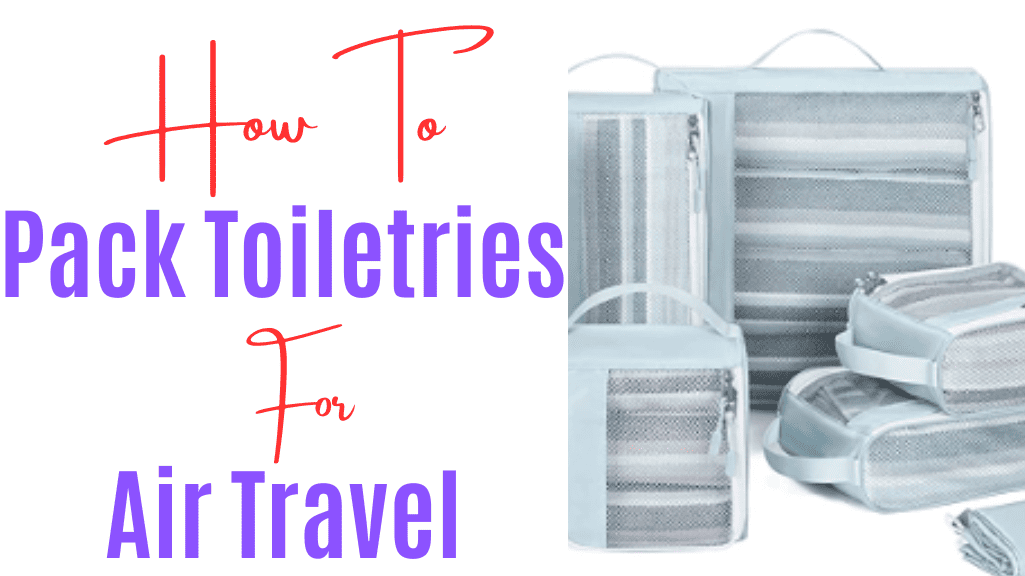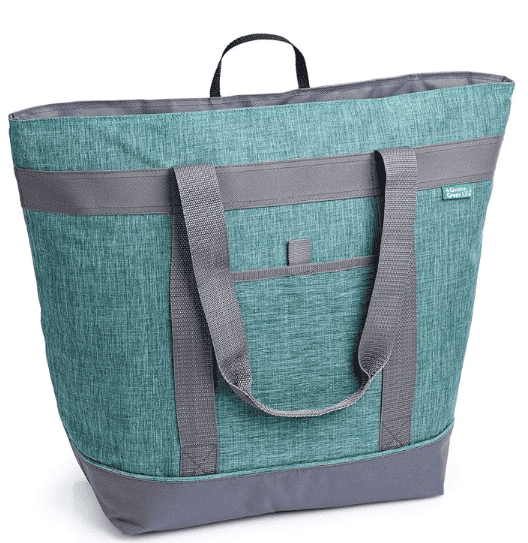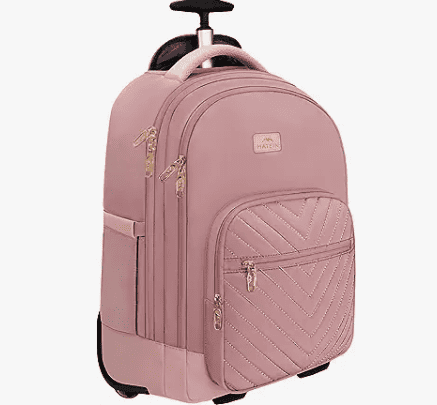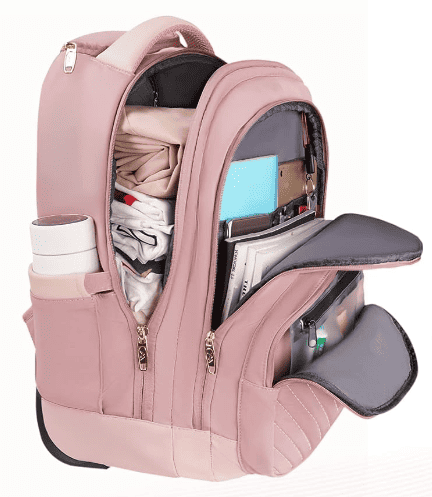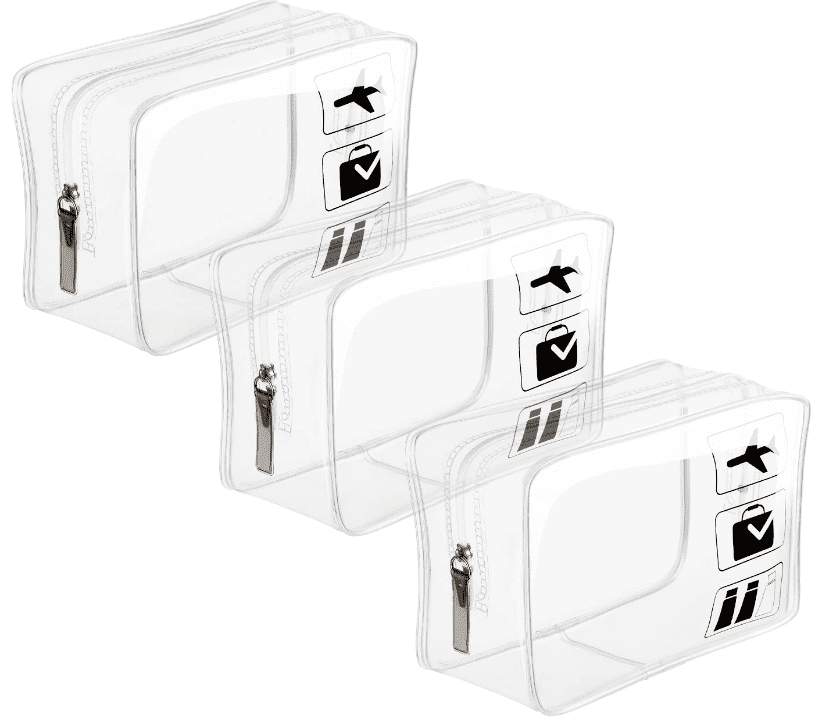Sometimes we want to travel light, this post will explain how to pack toiletries for air travel like a pro and still have everything you need to take with you.
Traveling by air requires careful planning, especially when packing toiletries, given airport security restrictions and limited luggage space
Packing toiletries for air travel is both an art and a science with a travel bag, designed to maximize convenience while adhering to the Transportation Security Administration (TSA) guidelines.
Travelers must navigate through the rules that dictate the size and packaging of allowed items, ensuring their personal care products are readily accessible and do not exceed quantity limits.
To efficiently pack toiletries for air travel, one must select containers that comply with the TSA’s 3-1-1 liquid rule, which allows travelers to carry liquids, aerosols, gels, creams, and pastes in containers that hold 3.4 ounces or less per item, all neatly packed within a single quart-sized, clear, zip-top bag. 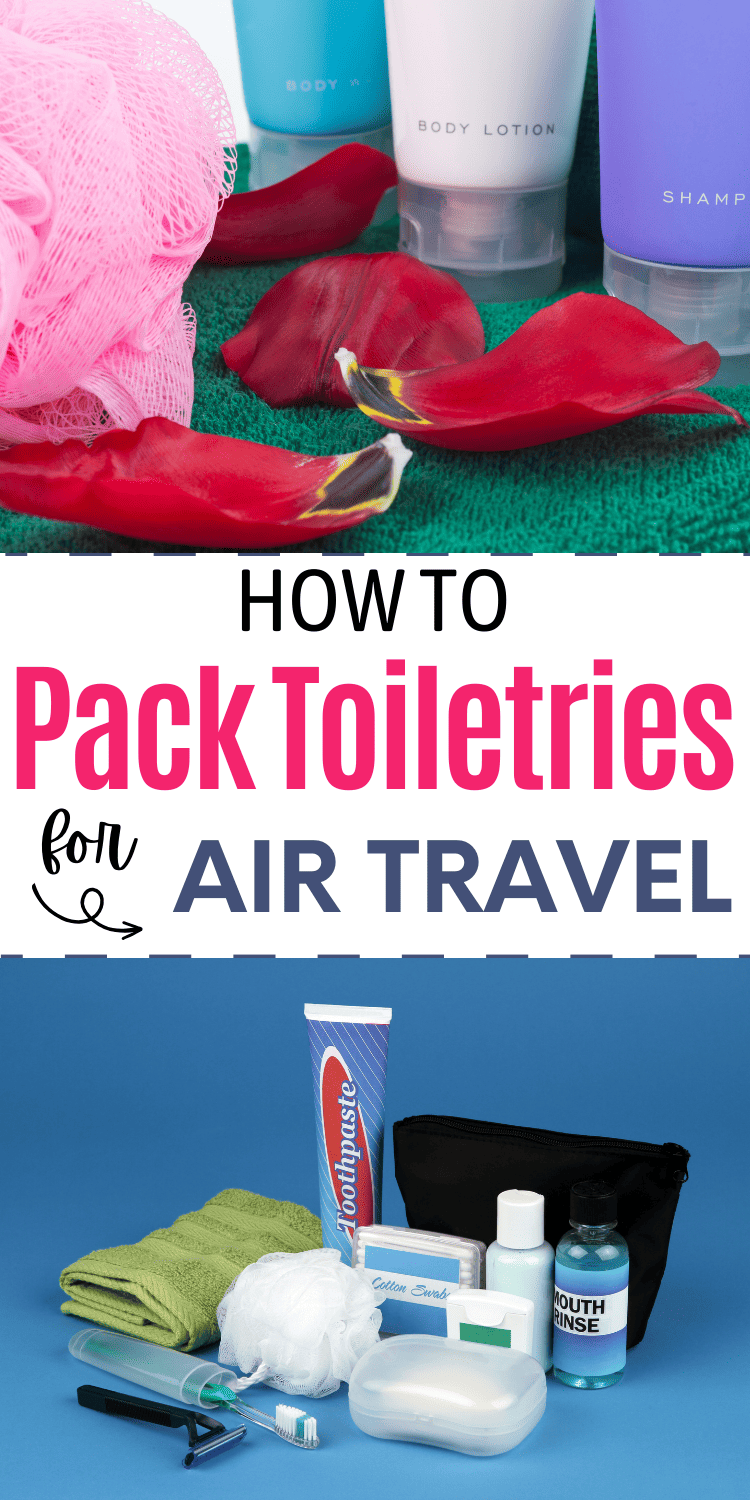
In addition to understanding these regulations, travelers should consider the length of their trip, their destination’s climate, and any personal grooming routines that could influence the contents of their toiletry bag.
Intelligent packing goes beyond merely meeting regulations; it also involves selecting multi-purpose products to save space.
Choosing solid or powder alternatives to liquids where possible, and understanding the distinction between what’s necessary for carry-on luggage and what can be stored in checked baggage.
Strategically packing toiletries can significantly ease one’s travel experience, allowing travelers to move swiftly through security checkpoints and enjoy their flight with the assurance that their personal care essentials are in order.
Understanding Travel Restrictions
When packing toiletries for air travel, it is crucial to be aware of the TSA’s 3-1-1 rule (TSA) regulations, including the 3-1-1 liquids rule, to ensure a smooth security check experience.
What is The 3-1-1 Liquids Rule?
The 3-1-1 liquids ruleis enforced by TSA and dictates that all liquid products, gels, and aerosols carried in your carry-on luggage must adhere to the following guidelines:
- 3.4 ounces or less per container
- Placed in a single, transparent, quart-sized bag
- One bag per passenger
Passengers must present their bags of liquids separately when going through security. The table below summarizes the allowable specifications:
| Maximum Volume per Container | Type of Bag | Number of Bags Allowed |
| 3.4 ounces / 100 milliliters | Transparent, quart-sized, resealable plastic bag | One per passenger |
Noncompliance with the 3-1-1 rule can lead to delays and even the disposal of non-adhering items during security checks.
But with proper and clever packing, you can stay within tsa requirements and still take most of your essential items and beauty products with you.
You may like
Is toothpaste allowed in carry-on luggage?
The best luggage for international travel
Security Checks and Regulations
During security checks, travelers must remove their quart-sized bags from carry-on luggage and place them in a bin for X-ray screening. TSA regulations require that at all :
- The bag is easily accessible.
The contents are clearly visible to TSA officers at the security checkpoint.
Containers larger than 3.4 ounces are packed in checked baggage.
It is your responsibility as a traveler to ensure all toiletries are compliant with these TSA regulations, as stringent checks are in place to maintain safety standards for all passengers for local and international flights.
Non-compliant items may be confiscated, and passengers could face additional screening procedures. Compliance helps expedite the security process and prevents unnecessary hold-ups in the security line.
Selecting Appropriate Containers
When packing toiletries for air travel, selecting the right containers is crucial to comply with Transportation Security Administration (TSA) regulations and to prevent leaks that can ruin luggage contents.
You should put your toiletries in a quart bag or freezer packs in case any liquid toiletries lid opens during your travel.
Choosing the Right Toiletry Bag
A traveler must select a toiletry bag that is compact yet spacious enough to hold all necessary items.
TSA-approved clear toiletry bags are recommended, as they expedite the security screening process. The bag should have separate compartments for better organization and easy access to your travel-size toiletries.
I love this Clear airport-compliant waterproof quart-size bag, it`s waterproof so there is no risk of spills.
Utilizing Travel-Sized Products
All liquids, aerosols, gels, creams, and pastes must be in travel containers that are 3.4 ounces (100 milliliters) or less and should fit comfortably in one quart-sized, resealable plastic bag.
As a traveler, you can purchase travel-sized products or transfer larger product quantities into smaller clear bags, or in TSA-compliant containers.
- Tip: Using a permanent marker to label these containers can help quickly identify contents.
Leak-Proof and Water-Resistant Options
Containers must be leak-proofto prevent spillage. Bottles with a secure screw-top lid or dispensers with a lockable pump are often reliable choices.
For added protection, place these containers in Ziploc bags or other resealable plastic bags. Water-resistant bags offer extra assurance against damage from outside moisture.
- Suggested Materials: Silicone or hard plastic
- Hanging Toiletry Organizer: Opt for a hanging organizer with multiple pockets. This keeps countertops clear and items accessible in cramped hotel bathrooms.
- Deodorant: Many brands offer solid stick versions, which are less messy and more temperature stable.
- Toothpaste: Consider a mini tube.
- Shampoo and Conditioner: Use small bottles or solid bars or dry shampoo.
- Deodorant: Opt for a travel-sized stick.
- Skincare Products: Transfer creams into small jars.
- Makeup: Select multi-purpose products and leave behind non-essentials.
- Colder Climates: Bring heavier moisturizers and lip balm to combat dry air.
- Hotter Climates: Prioritize sunscreen and after-sun lotion.
Extra Step<: wrap container threads with the plumber tape to reinforce seal. selecting appropriate containers for air travel toiletries not only ensures compliance regulations but also provides peace of mind that belongings will arrive at destination intact.>
You may like
20 of the best suitcases for teens
Can you bring tea bags on a plane?
Organizing Toiletries Efficiently
When packing toiletries for air travel, the key is to optimize for space and organization. This prevents leaks and makes it easy to access what you need upon arrival.
Not only that but with good organization, you can make more space and take that extra bikini or an extra dress.
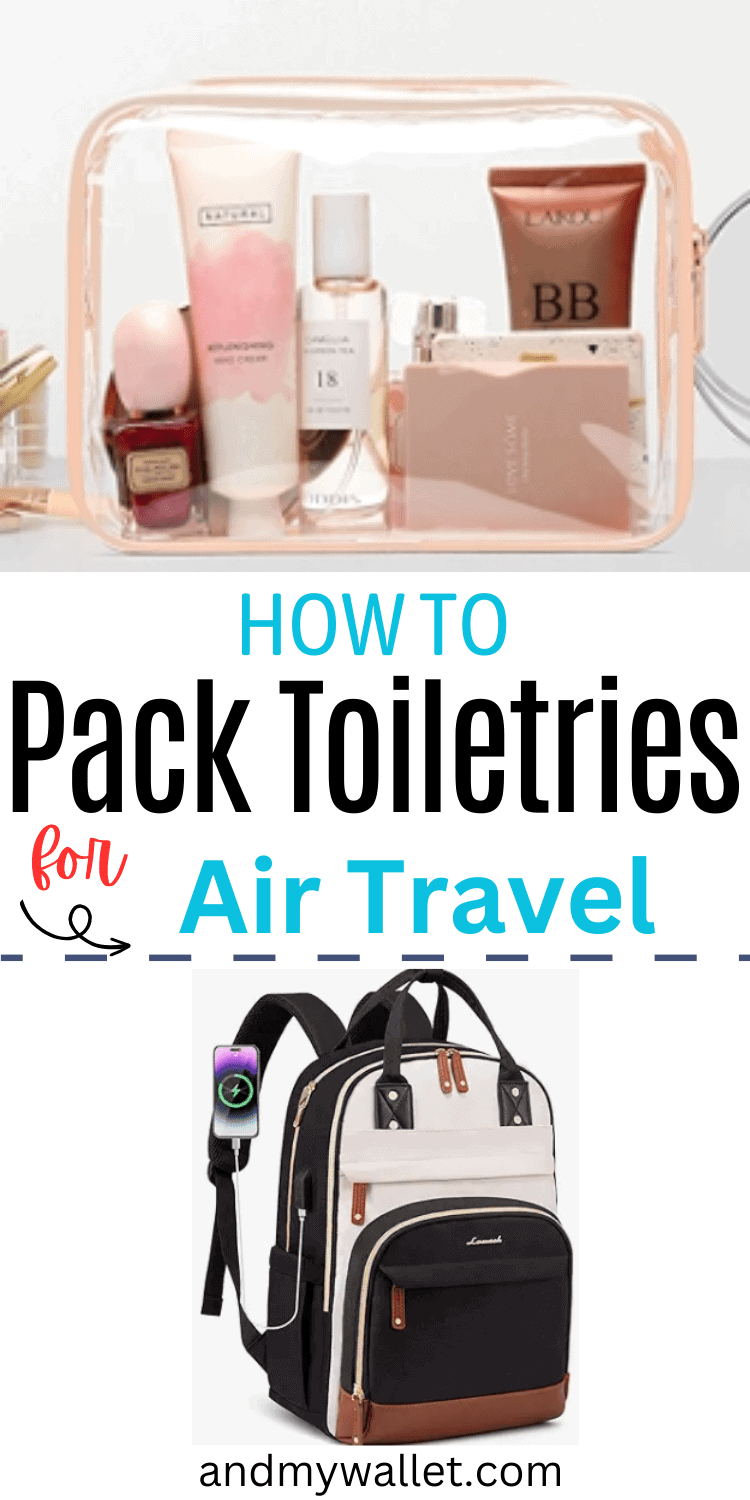
Employing Packing Organizers
Packing organizers such as packing cubes and a hanging toiletry organizer are imperative for efficient organization.
They add structure to your luggage and enable the categorization of items by use or size without taking up too much space. Here is how to best employ these tools:
- Packing Cubes: Useful for grouping similar products together. Assign categories like dental care, skincare, or hair products to different cubes.
Printable Toiletries Checklist:
Maximizing Space with Packing Techniques
Effective packing techniques help travelers make the most of limited luggage space. Follow these steps to maximize space:
- Decanting Liquids: Transfer liquids into travel-sized containers. Not only do they save space, but also help meet airline liquid restrictions.
Layering: Place flat items, like flat packs of wipes or facial masks, at the bottom of your suitcase.
Rolling and Folding: Roll or fold items to fit into small nooks within the suitcase, utilizing all available space.
By incorporating these methods with the use of organizers, travelers ensure toiletries are compactly stored and easy to find.
Packing Solid Toiletries
When packing for air travel, solid toiletries can streamline the process, offering convenience and compliance with TSA guidelines without compromising on items you need.
Benefits of Solid Toiletries
Solid toiletries are less likely to spill or leak compared to liquids, reducing the risk of damage to other items in your luggage.
They also bypass the TSA’s 3-4-1 liquids rule—a regulation restricting travelers to containers of 3.4 ounces or less in a single quart-sized bag—making them ideal for carry-on luggage.
Suggested Solid Toiletry Items
Travelers should consider packing the following solid toiletry items to save space and avoid spills:
- Solid Shampoo and Conditioners: These come in bar forms. Shampoo bar last longer than their liquid counterparts.
Soap: An essential item, available as bars that are compact and easy to pack, leave that shower gel and take bar soap instead.
Toothpaste tablets: Toothpaste tablets come in natural mint, with or without fluoride. Taking a tablet of toothpaste leaves you space to take other toiletry items or a hand sanitizer or lip gloss.
Tip: To keep solid toiletries dry and maintain their integrity, one should store them in breathable containers or wrap them in wax paper.
You may like
Can you take a facewash on a plane?
Finalizing Your Toiletry Pack For Air Travel
Properly finalizing a toiletry pack involves reviewing and downsizing the content, as well as adjusting to specific items for specific destination requirements.
Reviewing and Downsizing
One should begin the finalization process by laying out all selected toiletries and reviewing each item critically. It’s important to eliminate any unnecessary products to avoid overpacking.
Items can often be downsized by transferring them into travel-sized containers, which should be 100ml/3.4 ounces or less to comply with air travel regulations.
The checklist below offers a structured approach to downsizing:
Fragrances: Use samples or a refillable mini sprayer.
After this review, your toiletry bag should only contain items you are certain to use, and each should be in the most compact, travel-friendly form available especially if you are going on a short trip if you pack well, you`ll not need things like a dopp kit.
Adapting to Destination Requirements
When finalizing toiletries for travel, it’s crucial to consider the climate and norms of the destination.
Travelers going to Europe, for example, might find that most accommodations provide basic toiletries, allowing them to pack less. Conversely, a destination with a tropical climate might necessitate additional items like sunscreen or insect repellent.
Here’s a guide to tailor your toiletry pack to the destination’s climate:
Humid Environments: Pack anti-frizz hair products and powder-based cosmetics to resist moisture.
Moreover, research local regulations and customs regarding toiletries.
Some destinations might have strict waste management policies, favoring biodegradable products, or specific rules about importing certain substances.
This information is crucial for a stress-free passage through customs and comfortable travel.
Frequently Asked Questions About Toiletry Packing
Navigating the complexities of airport security with toiletries in tow can be straightforward with the right information.
The following answers to common queries will ensure travelers are prepared and compliant with regulations.
What are the TSA guidelines for packing liquids in carry-on bags?
The TSA enforces the 3-1-1 liquids rule, which allows travelers to carry liquids, gels, aerosols, creams, and pastes in containers up to 3.4 ounces (100 ML) each.
These items must fit in a single, quart-sized, zip-top, clear plastic bag. I covered this in the past but in case you missed it, you can check The TSA regulations here.
How can I effectively pack my makeup and toiletries in my carry-on luggage?
To effectively pack makeup and toiletries, utilize travel-sized containers for your products.
Consider multi-purpose items to save space and choose solid versions of toiletries, like solid perfume sticks, to avoid liquid restrictions.
Can full-sized toiletry items be included in my checked baggage?
Full-sized toiletry items can be included in checked baggage without adhering to the 3-1-1 rule as in carry-on baggage.
However, it’s wise to secure them in leak-proof containers or plastic wrap bags to prevent spillage onto other items.
Which type of bag is best for carrying toiletries while adhering to TSA regulations?
A clear, quart-sized, zip-top plastic bag is best for carrying toiletries per TSA regulations. This ensures that the contents are visible during the security screening process.
What items should I include on my toiletries packing list for air travel?
Essential toiletry items for air travel include a toothbrush, toothpaste, deodorant, shampoo, conditioner, soap, moisturizer, sunblock, body wash, and any personal hygiene items.
Ensure they are travel-sized if packed in carry-on bags. Please be informed that safety razors and straight razors are not allowed, you can take an electric razor without a problem.
Do my toiletries need to be in a transparent bag at the airport security check?
Yes, toiletries need to be in a transparent, quart-sized bag for airport security checks. This allows TSA agents to quickly verify compliance with the liquid rules without opening the bag or handling its contents.
Conclusion On How To Pack Toiletries For Air Travel
In conclusion, although packing for air travel can be stressful and limiting, there are always alternatives to ensure you have your essential toiletries with you.
From being strategic with your packing to utilizing duty-free shops at the airport, there is no need to sacrifice your favorite products or compromise on hygiene during your travels.
If all else fails, embrace the minimalistic approach and prioritize the absolute necessities.
No matter what option you choose, one thing is for sure – you can still maintain that fresh and clean feeling even while traveling!
How do you pack when you travel? I`d like to hear your ideas, especially regarding packing skincare and beauty products.
I hope you found this post about how to pack toiletries for Air travel useful and helpful for your future flights, happy travels!
